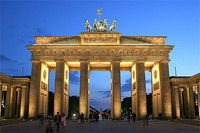Berlin Tourism - hotel and hostel online reservations to Berlin
Berlin is, historically speaking, one of the most  controversial city in Europe. By its famous Berlin Wall, it used to symbolize a place of the paradigmatic border between East and West, whereas nowadays it is said to profess tolerance, internationality, liveliness and openness to the world. The main attractions which place Berlin on the tourist map of Europe are represented by the active nightlife enabled by the many cafés, clubs and bars, by the street art, but also by historically and culturally interesting objectives, such as museums or palaces.
controversial city in Europe. By its famous Berlin Wall, it used to symbolize a place of the paradigmatic border between East and West, whereas nowadays it is said to profess tolerance, internationality, liveliness and openness to the world. The main attractions which place Berlin on the tourist map of Europe are represented by the active nightlife enabled by the many cafés, clubs and bars, by the street art, but also by historically and culturally interesting objectives, such as museums or palaces.
A particular feature of Berlin is the architectural variety which occurred as a consequence of historical circumstances. This variety ranges from the medieval buildings located in the surroundings of Alexanderplatz to the futuristic architecture embodied by the steel and glass structures in Potsdamer Platz.
Short History of Berlin
First mentioned in the 12th century, Berlin excels historically only as from the 18th century, when it becomes the capital of the Kingdom of Prussia; at the beginning of the 19th century, Berlin becomes the capital city of the Weimar Republic, and during the 19th century, it becomes the capital of the Third Reich. World War II marked the division of the city into East Berlin and West Berlin, but after the fall of the Berlin Wall in 1989, the city became, once again, the capital of Germany in its entirety.
Accommodation in Berlin
An appealing feature of hotels and other accommodation places in Berlin is represented by the relatively cheap prices, regardless of the rating of the lodging locations. Even 5-star hotels offer high quality services for low prices due to the development of constructions which boosted up following the end of the Cold War. However, the tourist looking for even cheaper services may take into consideration the offers made available by youth hostels and hostels in general.
Berlin Gastronomy
In case bed and breakfast offers do not entirely satisfy the tourist, one can always find a solution in eating out. Berlin’s restaurants excel by being amazingly inexpensive as compared to any other Western European capital or other German cities. German cuisine does not stand out by particular dishes, since it is rather a multicultural cuisine. In Berlin, one has always the chance to find restaurants representing many of the cuisines of the world. However, the currywurst may be deemed one of the few traditional courses one can eat in Berlin.
Tourist Attractions and Objectives in Berlin
More than 15 museums, six important churches and numerous art galleries are available for tourists with rather cultural interests. Other objectives with a special historic interest are the Memorial to the Murdered Jews of Europe, the Berlin War Memorial and the Checkpoint Charlie. The two Zoos and the Aquarium, as well as the numerous parks and gardens can be added to the list of tourist objectives. However, the Brandenburg Gate and the Kaiser Wilhelm Memorial Church are a must by force of their historical and cultural importance.
Berlin Events and Festivals
The most world renowned festival in the city is the Berlin Film Festival. Lange Nacht der Museen is an event consisting of museums being opened until 2 a.m. and of other manifestations near the city. Fête de la Musique and Oberbaumbrücke Festival can be added to this list, but one should not forget other manifestations, such as Christopher Street Day, Hanf Parade, Karneval der Kulturen, the Karneval in late February or early March or, why not, the Fuckparade in August, each of these having its own particular significance.